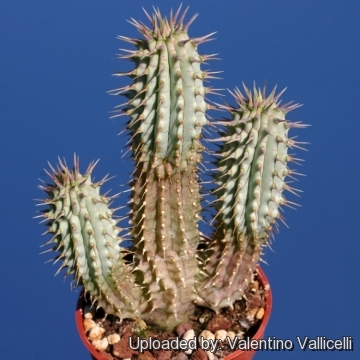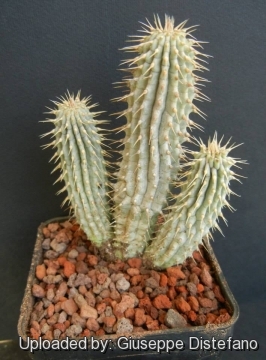Accepted Scientific Name: Hoodia currorii (Hook.) Decne.
Prodr. [A. P. de Candolle] 8: 665. 1844 [mid Mar 1844] DC. et al.

Hoodia macrantha Photo by: Valentino Vallicelli
It is an easy-to-grow species in this interesting genus.
Origin and Habitat: Namibia (Ebony to Usakos) The species is also known to exist in the Richtersveld in northern South Africa.
Habitat: Very arid stony deserts, dry short forest and dry acacia shrub vegetation from the costal Namib desert up to 250 km to the interior. This area is home to a wide range of unique plant species.
Synonyms:
See all synonyms of Hoodia currorii
back
Accepted name in llifle Database:Hoodia currorii (Hook.) Decne.Prodr. [A. P. de Candolle] 8: 665. 1844 [mid Mar 1844]Synonymy: 10
back
Common Names include:
ENGLISH: Hoodia
Description: Spiny, cactus-like columnar or sprawling succulent, with numerous stems. Slow growing but can get 40-80(-100) cm high.
Stem: Cylindrical, grey brown-purplish or greenish up to 8 cm in diameter and up to 1 m long.
Ribs: 11-24 vertical, with prominent obtuse tubercles.
Spines: One at the tip of each tubercle, sharp, 6-10 mm long.
Flowers: Subapical in group of 1 to 4, opening successively satellite dishes-like consisting of a short pentagonal tube and a subcircular limb, hairy, pink-purple to red-orange with yellow on the ribs 4-18 cm in diameter, the largest in the genus, has the horrible smell of rotten meat which attracts flies, they pollinate the plant and keep its generation alive. Without flies there would be no Hoodia macrantha.
Remarks: There are many difficulty in Hoodia identification. If we have some plants from unidentified origin ( plants provided unlabeled or with poor identification data), we have to wait until the plant is in flower and also specialists and growers have quite a difficulty to identify correctly this plants.
Subspecies, varieties, forms and cultivars of plants belonging to the Hoodia currorii group
 Hoodia macrantha Photo by: Valentino Vallicelli
Hoodia macrantha Photo by: Valentino Vallicelli Hoodia macrantha Photo by: Giuseppe Distefano
Hoodia macrantha Photo by: Giuseppe DistefanoCultivation and Propagation: It is one of easiest species to grow but prone to root rot due to overwaterings and lack of fresh air. Water normally in the growing season, sparsely in the winter. It is usually recommended to over-winter them in warm conditions (at 10° C), but despite their African origins they seem to grow well and flower without the extra heat which one might have thought necessary, and occasional temperatures near 0°C (or less). are tolerated, if kept dry.
Spring: In the spring leaving them out in the rain may provide them with the water they need.
Summer: In the summer months they will grow well in full sun or partial shade and tolerate heavy rain, but will be just as happy if the season is dry.
Potting medium: Since roots are quite shallow, a gritty, very free-draining compost with extra perlite or pumiceis suitable, and clay pots help the plants to dry out between watering. Indoors only in brightest position,
Propagation: Seed and by cutting from the base of a branch. Allow cuttings to dry several days before planting.
Hodia corrorii** ( = macrantha** ), along with the more famous ***Hoodia gordonii** , is considered to be a weight loss “wonder plant” by the world for over the last 3 decades. It has been used for centuries by Bushmen to treat high blood pressure, to promote a feeling of wellbeing and as an appetite suppressant (It was used by hunters for keeping hunger pangs at bay as they was deprived of food on long hunting expeditions in the desert, and famine was common). The stems of Hoodia plants that have had their spines removed are the preferred portion of the Hoodia plant for eating. Some manufacturers of dietary supplements describe the use of stems in their slimming pill , but this statement is quite inaccurate, because it is the whole aerial part of the plant that is dried for the preparation of bulk Hoodia powder. Hoodia species have a bitter taste, which is quite noticeable after eating.












